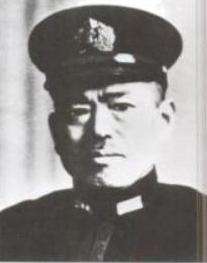Sentarō Ōmori
Sentarō Ōmori (大森 仙太郎, Ōmori Sentarō, 3 October 1892 – 24 December 1974), was an admiral in the Imperial Japanese Navy during World War II.
Sentarō Ōmori | |
|---|---|
 Admiral Sentarō Ōmori | |
| Native name | 大森 仙太郎 |
| Born | 3 October 1892 Kumamoto Prefecture, Japan |
| Died | 24 December 1974 (aged 82)[1] |
| Allegiance | |
| Service/ | |
| Years of service | 1913–1945 |
| Rank | |
| Commands held | |
| Battles/wars |
|
Biography
Early life
Ōmori was born in Kumamoto prefecture and graduated from the 41st class of the Imperial Japanese Naval Academy in 1913. He was ranked 16th out of 118 cadets. He served his midshipman duty aboard the cruiser Azuma, battleships Kongō and Iwami, and was commissioned as an ensign in 1914. He subsequently served on the battleship Yamashiro and destroyer Shirayuki.
Ōmori returned to school, and became a torpedo expert. He served as lieutenant on the destroyers Ashi and Nokaze and the battleship Mutsu before being given his first command on 1 December 1923: the destroyer Hibiki.
Through the 1920 and 1930s, Ōmori subsequently commanded the destroyers Namikaze, Kamikaze and Yugiri, seaplane tender Kawakami Maru, and finally the battleship Ise from 1939–1940, while steadily increasing in rank and returning at regular intervals to torpedo school to remain expert on the latest developments in torpedo technology and tactics. He was promoted to rear admiral on 15 November 1940.
World War II
At the start of World War II, Ōmori was in command of Destroyer Squadron 1 (DesRon1), which accompanied the main strike force during the attack on Pearl Harbor. It also participated in the Indian Ocean Raid of early 1942. During the Battle of Midway, DesRon1 directed the occupation of Attu Island in the Battle of the Aleutian Islands. Omori was given command of Cruiser Division 5 (CruDiv5). Assigned to the Solomon Islands, he was ordered to attack American transports off Bougainville Island in early November 1943. In the resultant Battle of Empress Augusta Bay of 1–2 November 1943, the Japanese forces (heavy cruisers Myōkō and Haguro, light cruisers Agano and Sendai, and destroyers Shigure, Samidare, Shiratsuyu, Naganami, Hatsukaze, and Wakatsuki) suffered a decisive defeat. Ōmori and his heavy cruisers narrowly escaped damage in an air raid at Rabaul, New Britain the following day, and retreated to the main Japanese base at Truk, Caroline Islands. Ōmori was relieved of his command for having withdrawn at Empress Augusta Bay against an inferior force and was sent back to Japan.
Ōmori became Commandant of the Torpedo School, and was promoted to vice admiral on 1 July 1944. He was director of the Special Attack Division from 13 September 1944–10 August 1945, supervising work with the Kaiten human-guided torpedoes. At the very end of World War II, he was appointed Commander in Chief of the IJN 7th Fleet.
Ōmori died on 24 December 1974.
References
Books
- D'Albas, Andrieu (1965). Death of a Navy: Japanese Naval Action in World War II. Devin-Adair Pub. ISBN 978-0-8159-5302-9.
- Dull, Paul S. (1978). A Battle History of the Imperial Japanese Navy, 1941-1945. Naval Institute Press. ISBN 978-0-87021-097-6.
- Fuller, Richard (1992). Shokan: Hirohito's Samurai. London: Arms and Armour Press. ISBN 978-1-85409-151-2.
- Hara, Tameichi (1961). Japanese Destroyer Captain. New York & Toronto: Ballantine Books. ISBN 978-0-345-27894-4.
- Kilpatrick, C. W. (1987). Naval Night Battles of the Solomons. Exposition Press. ISBN 978-0-682-40333-7.
- Lacroix, Eric; Linton Wells (1997). Japanese Cruisers of the Pacific War. Naval Institute Press. ISBN 978-0-87021-311-3.
- McGee, William L. (2002). "Bougainville Campaign". The Solomons Campaigns, 1942-1943: From Guadalcanal to Bougainville--Pacific War Turning Point, Volume 2 (Amphibious Operations in the South Pacific in WWII). BMC Publications. ISBN 978-0-9701678-7-3.
- Morison, Samuel Eliot (1958). Breaking the Bismarcks Barrier, vol. 6 of History of United States Naval Operations in World War II. Castle Books. ISBN 978-0-7858-1307-1.
External links
- Naval History via Flix. "Sentaro Omori". Retrieved 2007-02-28.
- Nishida, Hiroshi. "Imperial Japanese Navy". Archived from the original on 2013-01-30. Retrieved 2007-02-25.
- Hackett, Bob; Sander Kingsepp. "HIJMS HAGURO: Tabular Record of Movement". Combinedfleet.com. Retrieved 2006-06-14.
- Muir, Dan. "Order of Battle, Battle of Empress Augusta Bay, 2 November 1943". Retrieved 2007-06-14.
- O'Hara, Vincent. "BATTLE OF EMPRESS AUGUSTA BAY - November 2, 1943". Retrieved 2007-06-14.
Notes
- Nishida, Imperial Japanese Navy